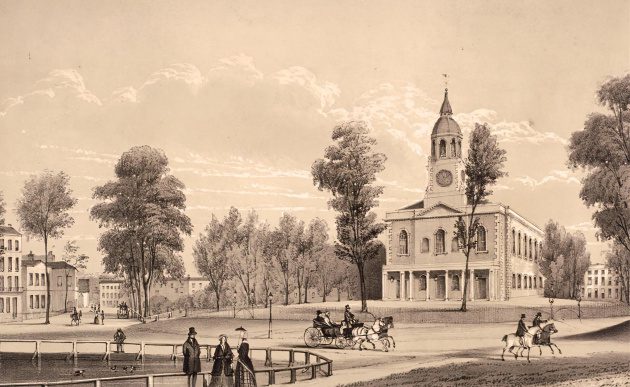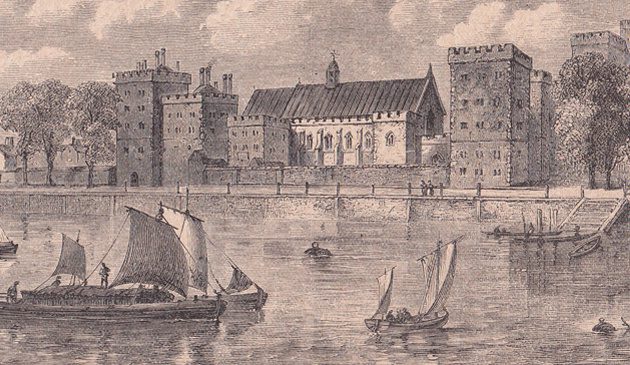The Bishops of London and Fulham Palace

Caption: The West Court of Fulham Palace with its surrounding Tudor buildings that were constructed in the late 15th century. The courtyard is entered through ancient oak gates and, apart from minor changes such as the addition of a clock in the 18th century, has looked the same since the 16th century. The clock bell is from 1676.
When Archibald Campbell Tait was appointed Bishop in 1856 the earlier chapels were no longer in use and instead the un-consecrated great hall was used for services. He had a new chapel erected as an addition to the south-west of the old Tudor buildings. It was designed by William Butterfield, richly decorated in polychrome brickwork and inlaid stone, with marble from other parts of the palace. The stained glass by Clayton & Bell featured the four Evangelists. The chapel was consecrated in 1867 and dedicated to the Holy Trinity. Tastes had changed by the latter part of the century and Bishop Mandell Creighton and his wife had the east wall covered. There was bomb damage in the Second World War that necessitated repair work during the 1950s. In that period Butterfield’s decorative brickwork was painted over with murals of Christian events by Brian Thomas and students of the Byam Shaw School of Drawing and Painting. A plain ceiling was also inserted below the original and a new stained-glass window of St. Peter, flanked by Bishops Creighton and William Wand, was designed by Sir Ninian Comper. The upper angel is modelled on Wand’s son who died in a mountaineering accident in 1934.
The meadows that surrounded the palace were frequently flooded and in 1874 considerable damage was done to the palace. A river wall was constructed in 1893 to prevent further occurrences. The moat was in water until filled with debris in the 1920s and now exists only as a ditch. In 1976 the remains of the moat and the 36 acres it encloses became a Scheduled Ancient Monument. Only 13 remain of the original 36 acres as the garden of the palace, with some other parts now used as allotments. The Bishop’s Meadow to the north-west of the palace was granted to the vestry by Bishop John Jackson in 1883 and the Bishop’s Park opened there in 1883.
The garden contains some rare trees. In the 16th century Bishop Edmund Grindal was exiled to Switzerland during the reign of Queen Mary. When he returned he brought a tamarisk, the first to be brought into England, which he planted in the garden. He sent grapes each year from the palace vines to Queen Elizabeth. Bishop Henry Compton was banished to Fulham by James II. During that time he developed a collection of hardy and exotic plants in the late 17th and early 18th centuries, said to be the finest in England. The botanist John Evelyn was a frequent visitor. Some plants were brought back from Virginia including sweetgum, magnolia and box elder. Compton’s cork oak was replaced by the existing tree in 1998. Formal enclosed gardens were replaced with open parkland and pleasure grounds as part of Bishop Terrick’s remodelling of the palace in the 18th century. During that time a two-acre walled garden was created, bordered by the surviving Tudor wall and gateway, and it continues to be maintained. Vegetables grown there were sent to the townhouse at St. James’s. The wife of Bishop Tait began a tradition of celebrated garden parties in the 1860s, which continued until economies forced their decline after the Second World War.
Adjacent to the palace grounds, beyond the walled garden, stands the parish church of All Saints. There has been a church on the site since at least the 13th century and the present Kentish ragstone bell tower dates from the middle of the 15th century. The building was no longer large enough as the population of the surrounding area increased in size during the 19th century, and it was liable to flooding from the river. In the latter part of the century the old building was demolished, except for the tower. A larger replacement was created on slightly raised ground by the architect Sir Arthur Blomfield, son of the former Bishop of London Charles James Blomfield, in the Gothic perpendicular style. Eleven Bishops of London are buried at All Saints and the church also contains memorials to several notable people of their time, as well as the tomb of the slavery abolitionist Granville Sharp.
Fulham Palace was listed as a Grade I building in 1954. The historic garden is listed as Grade II*. After the Second World War it was thought the palace was too large, inconvenient, and far from central London for the bishops. The last to live there was Robert Stopford and after 1973 the Church Commission leased it to Hammersmith & Fulham Council until 2075. They in turn leased the site to Fulham Palace Trust, an independent charity, in 2011 to manage and to restore the house and garden. The upper floors are rented out as offices. The Bishop now lives in a house at Dean’s Court, close to St. Paul’s Cathedral.
Sources include: Fulham Palace House & Garden – A Brief History; Edward Walford ‘Old and New London’ (1897).
<Back to Religion and Churches


